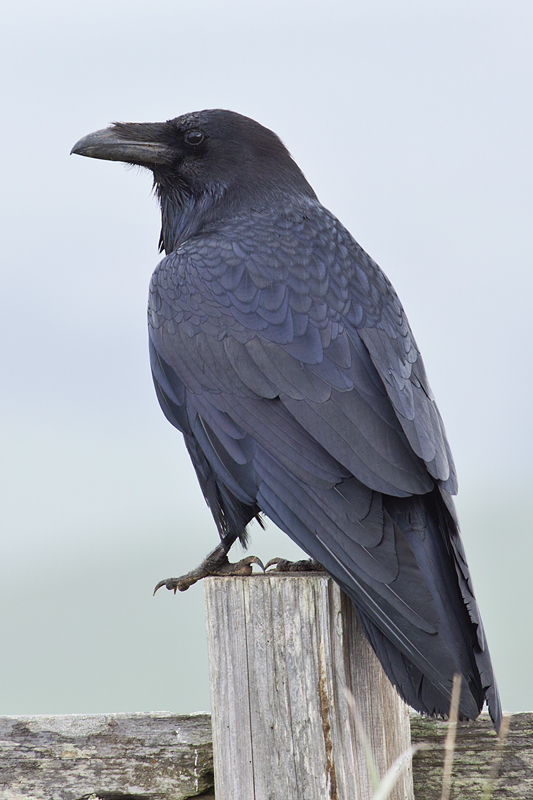
Corvus corax
The common raven is the largest perching bird in the world, with a wingspan of up to two feet. It is found throughout the northern hemisphere—including across California—and is the inspiration for countless characters in mythologies from a wide range of cultures.
Ravens vs Crows
While they look quite similar, ravens and crows are actually two distinct species. The American crow (Corvus brachyrhynchos) is smaller in size, has a more slender bill, lacks the distinctive tuft of feathers around the throat, and even has a different flight pattern. Ravens tend to soar more often than crows, and they can even fly upside down at times. They also have a wedge-shaped tail rather than a flat one, and unlike crows, they aren’t common in urban areas.
Distribution, Diet, and Nesting
Ravens can be found throughout the Los Padres National Forest and much of the rest of California. They prefer more open areas like chaparral and some woodlands. When hiking in the Los Padres, you will likely see a raven soaring overhead similar to a turkey vulture.
Like many other corvids, ravens have a diverse diet and are quite opportunistic. They are primarily scavengers, but they also prey on insects, amphibians, reptiles, birds and even some small mammals. Because they are so omnivorous and opportunistic, ravens unfortunately will also eat human garbage, which is often along roads and near developed areas.
Ravens tend to nest together for life once paired, though raven affairs have been observed. Their courtship behaviors include demonstrations of their intelligence and extravagant acrobatic displays.
Similar to California condors, they like to nest on cliff ledges and in large trees. These nests are generally made of twigs in a cup shape. After a female lays 3-7 eggs and incubates them for a little over two weeks, both the male and female will tend to the young before they fledge.
Intelligence and Playfulness
Ravens are one of the most intelligent bird species in the world. They have unusually large brains for their size—a trait they share with a few other species in the Corvidae family. Incredibly, ravens have been observed to solve complex problems on their own or by learning from others. They are also known to deceive intentionally.

During one study’s experiment in which ravens had to compete to find hidden caches of food, with some containing less or no food, a dominant male learned to follow a subordinate raven that was better at finding the best food stores. He would then chase away the subordinate. Interestingly, the subordinate raven began to trick the dominant male by leading him to the wrong food caches in later runs of the experiment, thus giving the subordinate a head start to the bigger rewards. However, the dominant male eventually realized the deception and learned to stop following the other raven.
Ravens are also well known to have advanced calls that contain complex messages. They have been observed to call wolves to the site of carcasses, where the wolves then open the carcass and make it more accessible to the ravens. Researchers have observed over 20 distinct calls that ravens use for communicating things like warning, threats, taunts, and even cheers.
Perhaps most surprising is that ravens, like many non-avian species, appear to engage in playful activities. Juvenile ravens are some of the most playful compared to other bird species. Ravens have even been observed to play in the snow similar to humans or dogs.
Conservation
While ravens populations are not currently threatened, they do prefer undisturbed mountain areas in our region. Our work to keep the Los Padres National Forest and other public lands truly wild is helping ensure that ravens have a place to feed, nest, and, of course, play.






